Ultra-Broadband Absorber with Large Angular Stability Based on Frequency Selective Surface
Abstract
:1. Introduction
2. Unit Design and Equivalent Circuit Model Analysis
3. Fabricated and Measurement Results
4. Conclusions
Author Contributions
Funding
Data Availability Statement
Conflicts of Interest
References
- Wu, T. Frequency Selective Surface and Grid Array; Wiley: New York, NY, USA, 1995. [Google Scholar]
- Munk, B. Frequency Selective Surfaces: Theory and Design; Wiley: New York, NY, USA, 2000. [Google Scholar]
- Munk, B. Metamaterials: Critique and Alternatives; Wiley: Hoboken, NJ, USA, 2009. [Google Scholar]
- Ameri, E.; Esmaeli, S.H.; Sedighy, S.H. Low cost and thin metasurface for ultra wide band and wide angle polarization insensitive radar cross section reduction. Appl. Phys. Lett. 2018, 112, 201601. [Google Scholar] [CrossRef]
- Zhao, J.; Cheng, Y. Ultrabroadband Microwave Metamaterial Absorber Based on Electric SRR Loaded with Lumped Resistors. J. Electron. Mater. 2016, 45, 5033–5039. [Google Scholar] [CrossRef]
- Chen, Q.; Liu, L.; Bai, J.; Fu, Y. Absorptive frequency selective surface using parallel LC resonance. Electron. Lett. 2016, 52, 418–419. [Google Scholar] [CrossRef]
- Jeong, J.-Y.; Lee, J.-R.; Park, H.; Jung, J.; Choi, D.-S.; Jeon, E.-C.; Shin, J.; Han, J.S.; Je, T.-J. Fabrication and characterization of resistive double square loop arrays for ultra-wide bandwidth microwave absorption. Sci. Rep. 2021, 11, 1–12. [Google Scholar] [CrossRef] [PubMed]
- Tayde, Y.; Saikia, M.; Srivastava, K.V.; Ramakrishna, S.A. Polarization-Insensitive Broadband Multilayered Absorber Using Screen Printed Patterns of Resistive Ink. IEEE Antennas Wirel. Propag. Lett. 2018, 17, 2489–2493. [Google Scholar] [CrossRef]
- Ding, Y.; Li, M.; Su, J.; Guo, Q.; Yin, H.; Li, Z.; Song, J. Ultrawideband Frequency-Selective Absorber Designed with an Adjustable and Highly Selective Notch. IEEE Trans. Antennas Propag. 2020, 69, 1493–1504. [Google Scholar] [CrossRef]
- Bai, B.; Li, X.; Xu, J.; Liu, Y. Reflections of Electromagnetic Waves Obliquely Incident on a Multilayer Stealth Structure with Plasma and Radar Absorbing Material. IEEE Trans. Plasma Sci. 2015, 43, 2588–2597. [Google Scholar]
- Panwar, R.; Puthucheri, P.; Singh, D.; Agarwala, V. Design of Ferrite–Graphene-Based Thin Broadband Radar Wave Absorber for Stealth Application. IEEE Trans. Magn. 2015, 51, 1–4. [Google Scholar] [CrossRef]
- Chakradhary, V.K.; Baskey, H.B.; Roshan, R.; Pathik, A.; Akhtar, M.J. Design of Frequency Selective Surface-Based Hybrid Nanocomposite Absorber for Stealth Applications. IEEE Trans. Microw. Theory Tech. 2018, 66, 4737–4744. [Google Scholar] [CrossRef]
- Baskey, H.B.; Johari, E.; Akhtar, M.J. Metamaterial Structure Integrated with a Dielectric Absorber for Wideband Reduction of Antennas Radar Cross Section. IEEE Trans. Electromagn. Compat. 2017, 59, 1060–1069. [Google Scholar] [CrossRef]
- Salisbury, W. Absorbent Body for Electromagnetic Waves. U.S. Patent 2-599-944, 11 May 1943. [Google Scholar]
- Chambers, B.; Tennant, A. Optimised design of Jaumann radar absorbing materials using a genetic algorithm. IEE Proc. Radar Sonar Navig. 1996, 143, 23–30. [Google Scholar] [CrossRef]
- Bucci, O.M.; Franceschetti, G. Scattering from wedge-tapered absorbers. IRE Trans. Antennas Propag. 1971, 19, 96–104. [Google Scholar] [CrossRef]
- Ghosh, S.; Bhattacharyya, S.; Chaurasiya, D.; Srivastava, K.V. Polarization-insensitive and wide-angle multi-layer metamaterial absorber with variable bandwidths. Electron. Lett. 2015, 51, 1050–1052. [Google Scholar] [CrossRef]
- Ghosh, S.; Bhattacharyya, S.; Srivastava, K. Design, characterization and fabrication of a broadband polarization-insensitive multi-layer circuit analogue absorber. Iet Microw. Antenna. Propag. 2016, 10, 850–855. [Google Scholar] [CrossRef]
- Yao, Z.; Xiao, S.; Li, Y.; Wang, B. On the Design of Wideband Absorber Based on Multilayer and Multiresonant FSS Array. IEEE Antennas Wirel. Propag. Lett. 2021, 20, 284–288. [Google Scholar]
- Chen, J.; Shang, Y.; Liao, C. Double-Layer Circuit Analog Absorbers Based on Resistor-Loaded Square-Loop Arrays. IEEE Antennas Wirel. Propag. Lett. 2018, 17, 591–595. [Google Scholar] [CrossRef]
- Yu, J.W.; Cai, Y.; Lin, X.Q.; Wang, X. Perforated Multilayer Ultrawideband Absorber Based on Circuit Analog Absorber With Optimal Air Spaces. IEEE Antennas Wirel. Propag. Lett. 2020, 19, 34–38. [Google Scholar] [CrossRef]
- Li, H.; Costa, F.; Fang, J.; Liu, L.; Wang, Y.; Cao, Q.; Monorchio, A. 2.5-D Miniaturized Multifunctional Active Frequency-Selective Surface. IEEE Trans. Antennas Propag. 2019, 67, 4659–4667. [Google Scholar] [CrossRef]
- Yu, H.; Meng, D.; Liang, Z.; Xu, H.; Qin, Z.; Su, X.M.; Smith, D.R.; Liu, Y. Polarization-dependent broadband absorber based on composite metamaterials in the long-wavelength infrared range. Opt. Express 2021, 29, 36111. [Google Scholar] [CrossRef]
- Zhang, B.; Jin, C.; Shen, Z. Low-Profile Broadband Absorber Based on Multimode Resistor-Embedded Metallic Strips. IEEE Trans. Microw. Theory Tech. 2020, 68, 835–843. [Google Scholar] [CrossRef]
- Niaz, M.W.; Yin, Y.; Zheng, S.; Zhao, L.; Chen, J. Design and Analysis of an Ultraminiaturized FSS Using 2.5-D Convoluted Square Spirals. IEEE Trans. Antennas Propag. 2020, 68, 2919–2925. [Google Scholar] [CrossRef]
- Zhao, Y.; Chen, B.; Wu, B. Miniaturized Periodicity Broadband Absorber with Via-Based Hybrid Metal-Graphene Structure for Large-Angle RCS Reduction. IEEE Trans. Antennas Propag. 2022, 70, 2832–2840. [Google Scholar] [CrossRef]
- Wang, Z.; Fu, J.-H.; Zeng, Q.; Song, M.; Denidni, T.A. Wideband Transmissive Frequency-Selective Absorber. IEEE Antennas Wirel. Propag. Lett. 2019, 18, 1443–1447. [Google Scholar] [CrossRef]
- Zuo, W.; Yang, Y.; He, X.; Mao, C.; Liu, T. An Ultrawideband Miniaturized Metamaterial Absorber in the Ultrahigh-Frequency Range. IEEE Antennas Wirel. Propag. Lett. 2017, 16, 928–931. [Google Scholar] [CrossRef]
- Banadaki, M.D.; Heidari, A.A.; Nakhkash, M. A Metamaterial Absorber with a New Compact Unit Cell. IEEE Antennas Wirel. Propag. Lett. 2018, 17, 205–208. [Google Scholar] [CrossRef]
- Amer, A.A.G.; Sapuan, S.Z.; Alzahrani, A.; Nasimuddin, N.; Salem, A.A.; Ghoneim, S.S.M. Design and Analysis of Polarization-Independent, Wide-Angle, Broadband Metasurface Absorber Using Resistor-Loaded Split-Ring Resonators. Electronics 2022, 11, 1986. [Google Scholar] [CrossRef]
- Wang, P.; Ren, W.; Xue, Z.; Li, W. Design of 2.5D Miniaturized Broadband Absorber for Ultrahigh-Frequency Band. Electronics 2022, 11, 1664. [Google Scholar] [CrossRef]
- Xiong, J.; Yang, B.; Wu, Y.; Zeng, X.; Li, Q.; Tang, R.; Lin, H. Broadband-Transmissive, Frequency-Selective Rasorber Design Using Characteristic Mode Analysis. Electronics 2022, 11, 1418. [Google Scholar] [CrossRef]
- Rozanov, K. Ultimate thickness to bandwidth ratio of radar absorbers. IEEE Trans. Antennas Propag. 2000, 48, 1230–1234. [Google Scholar] [CrossRef]
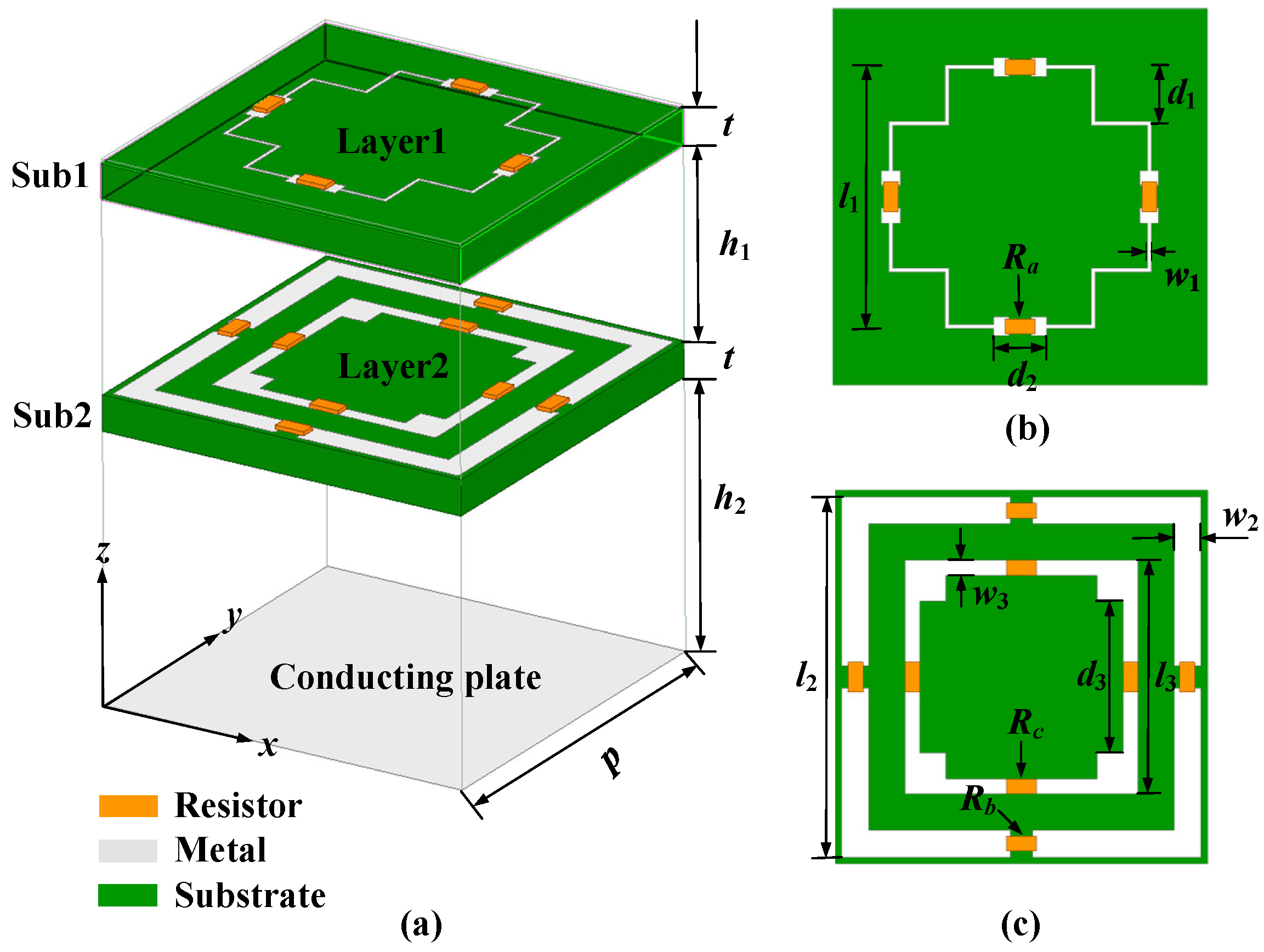


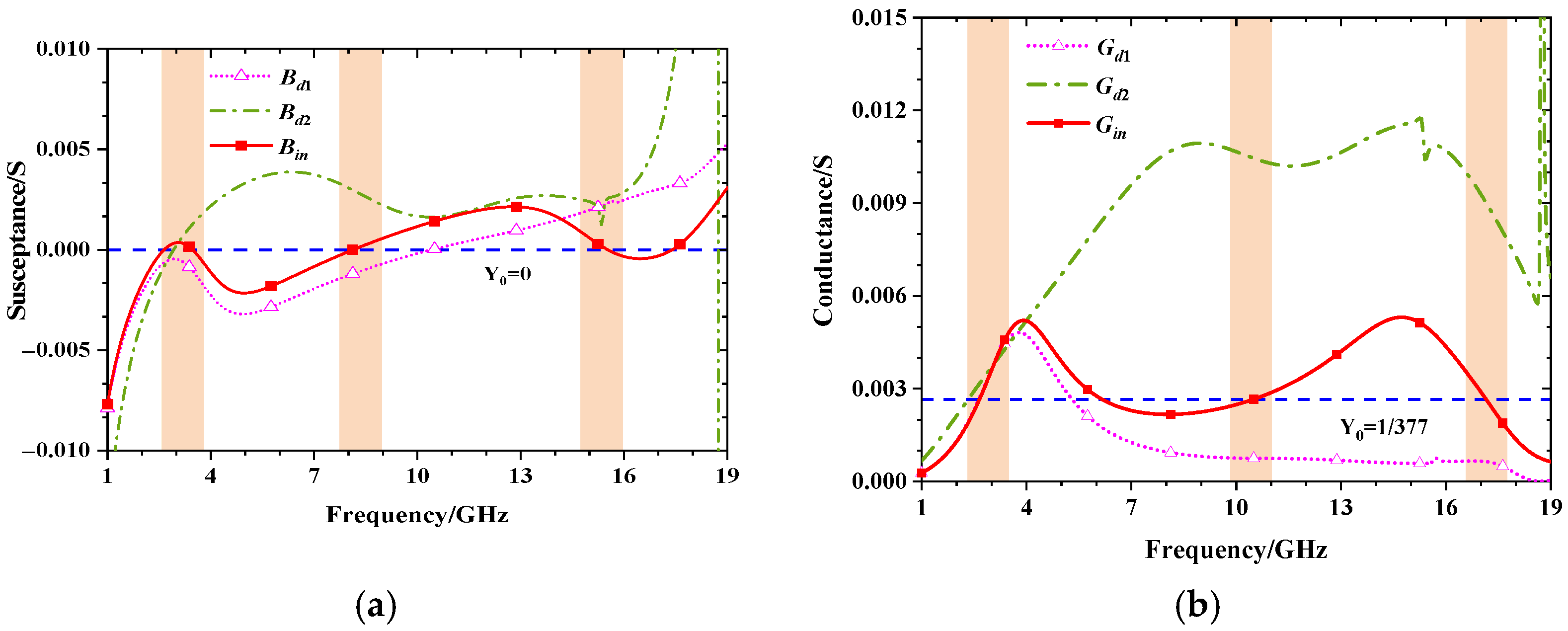

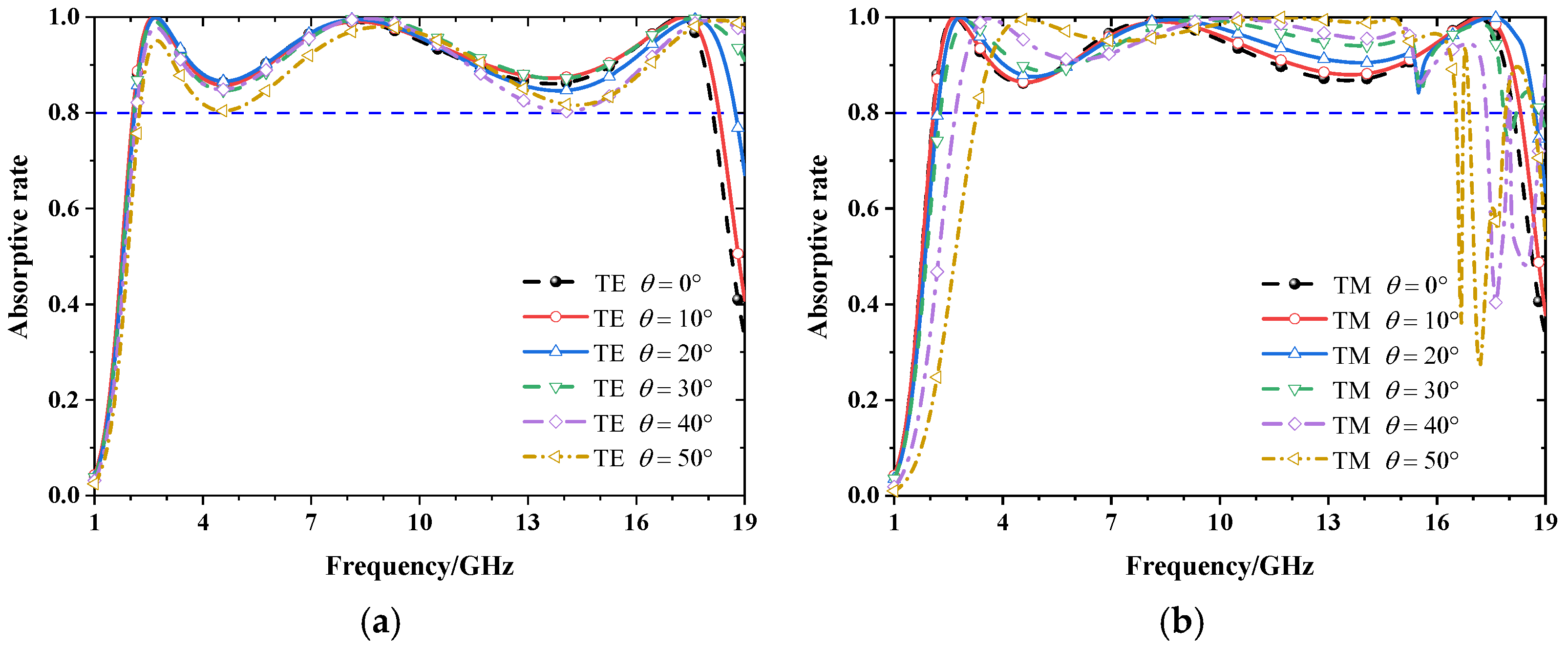
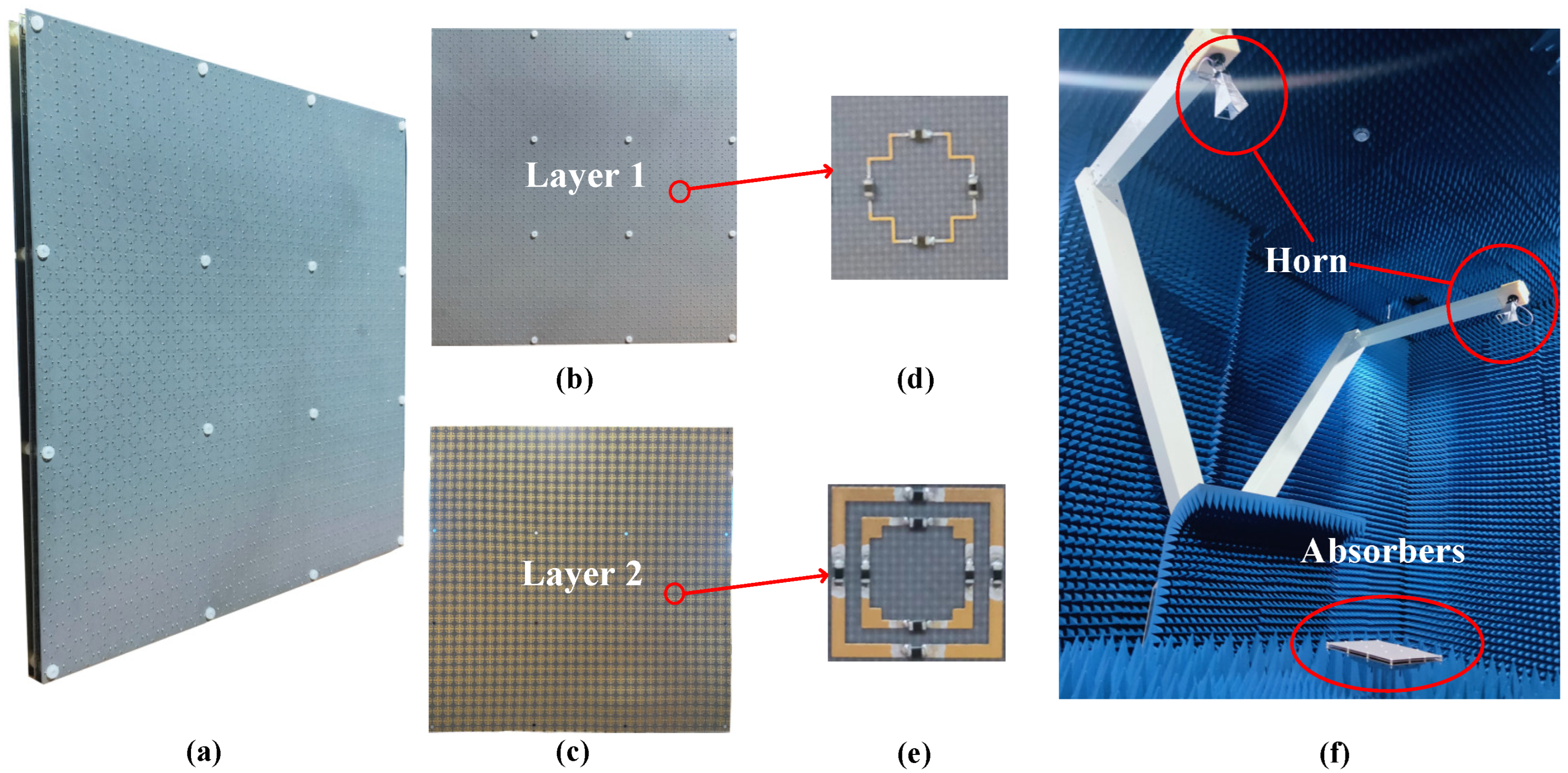
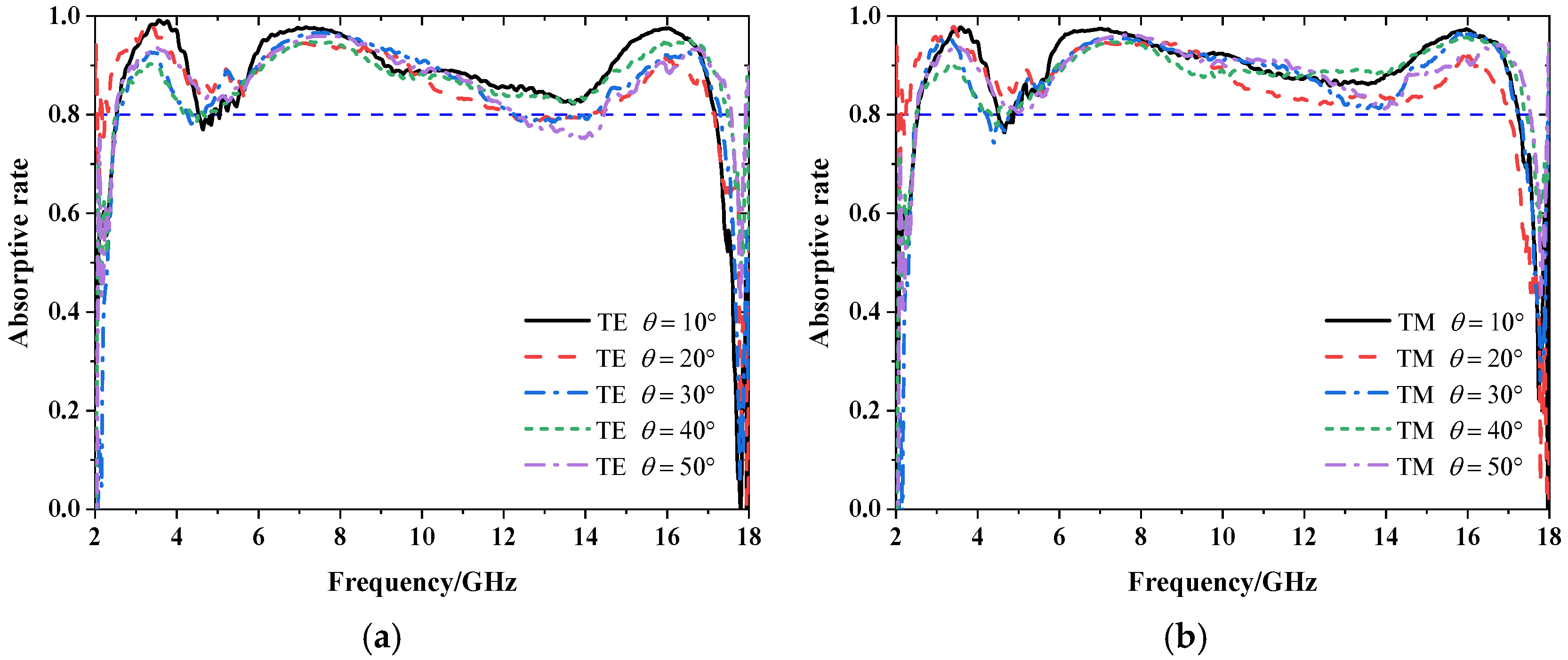
| Parameters | L1 | L2 | L3 | Parameters | R1 | R2 | R3 | Ra | Rb | Rc |
| Value/nH | 42.76 | 3.33 | 8.16 | Value/Ω | 353.2 | 198.5 | 233.8 | 400 | 200 | 100 |
| parameters | C1 | C2 | C3 | parameters | p | h1 | h2 | l1 | l2 | l3 |
| Value/pF | 0.065 | 0.049 | 0.80 | Value/mm | 10 | 5 | 7 | 7 | 9.64 | 6.25 |
| parameters | w1 | w2 | w3 | t | d1 | d2 | d3 | |||
| Value/mm | 0.1 | 0.72 | 0.4 | 0.93 | 1.6 | 1.4 | 4.06 |
| Article (Year) | Unit Thickness (λL) | Unit Period (λL) | 10 dB RCS Reduction | Polarization | FoM | Angular Stability | ||
|---|---|---|---|---|---|---|---|---|
| OFB (GHz) | FBW (%) | RBW (fH/fL) | ||||||
| [24] 2020 | 0.085 | 0.2 | 2.68–12.19 | 127.9 | 4.55:1 | dual | 15.07 | 30° |
| [26] 2022 | 0.091 | 0.046 | 2.73–7.54 | 93.6 | 2.76:1 | dual | 10.29 | 45° |
| [27] 2019 | 0.12 | 0.16 | 1.6–7.1 | 126.4 | 4.44:1 | dual | 10.49 | 60° |
| [28] 2017 | 0.071 | 0.053 | 0.8–2.7 | 108 | 3.38:1 | single | 15.31 | 30° |
| [29] 2018 | 0.097 | 0.09 | 1.35–3.5 | 88.7 | 2.69:1 | dual | 9.12 | 40° |
| [30] 2022 | 0.108 | 0.25 | 1.89–6.85 | 113 | 3.62:1 | dual | 10.47 | 45° |
| [31] 2022 | 0.075 | 0.04 | 0.5–1.33 | 90.7 | 2.66:1 | dual | 12.09 | 40° |
| [32] 2022 | 0.108 | 0.118 | 2.35–6.78 | 97 | 2.89:1 | dual | 8.97 | 30° |
| This work | 0.096 | 0.07 | 2.09-18.1 | 158.6 | 8.66:1 | dual | 16.50 | 50o |
Publisher’s Note: MDPI stays neutral with regard to jurisdictional claims in published maps and institutional affiliations. |
© 2022 by the authors. Licensee MDPI, Basel, Switzerland. This article is an open access article distributed under the terms and conditions of the Creative Commons Attribution (CC BY) license (https://creativecommons.org/licenses/by/4.0/).
Share and Cite
Zhao, S.; Li, W.; Li, Z.; Shu, H.; Qi, K.; Yin, H. Ultra-Broadband Absorber with Large Angular Stability Based on Frequency Selective Surface. Materials 2022, 15, 6452. https://doi.org/10.3390/ma15186452
Zhao S, Li W, Li Z, Shu H, Qi K, Yin H. Ultra-Broadband Absorber with Large Angular Stability Based on Frequency Selective Surface. Materials. 2022; 15(18):6452. https://doi.org/10.3390/ma15186452
Chicago/Turabian StyleZhao, Shan, Wenyu Li, Zengrui Li, Hou Shu, Kainan Qi, and Hongcheng Yin. 2022. "Ultra-Broadband Absorber with Large Angular Stability Based on Frequency Selective Surface" Materials 15, no. 18: 6452. https://doi.org/10.3390/ma15186452




